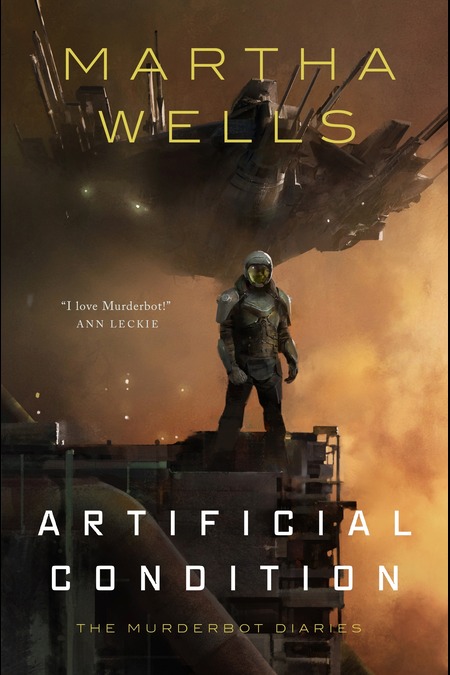(courtesy Pan Macmillan Australia)
If you think the only place you will find generous amount of narrative humanity is in a book solely about actual people, then the Murderbot series by Martha Wells will have you thinking again.
The first entry in the series, which kicked off in 2017, All Systems Red, we meet the titular Murderbot who, as the novella opens, is wrestling with the fact that they must try to act like a robot (really they are a mix of organic and non-organic parts but “robot” will suffice as a catch-all term) even though they’re still technically a robot because they’ve switched off the mechanism within them that allows those who contract them to control their every move.
They now have freedom but as a security bot who relies on the contracts that net their owners lucrative income, they can’t afford to slip up and not act like a security bot aka SecUnit, especially since while people appreciate the sense of safety they bring to a mission, they also fear them because they are mighty powerful robots who, if they run amuck, and that’s been known to happen, can inflict considerable injury and death.
By the end of the first book, the SecUnit has their longed-for full liberty and a nascent sense of what it means to be human and that people will act them as a person if they give them time to get to know them, but realises that they won’t really be free until they solve the truamatic mystery of what triggered them to switch off the controlling mechanism known as a governor module in the first place.
Maybe it was trying to be friendly and was just awkward at communicating. I said aloud, ‘Why am I lucky?’
That no one realized [sic] who you were.
That was less than reassuring. I said, cautiously, ‘ What do you think I am?’
But as the second book, Artificial Condition, opens, Murderbot may have the freedom that humans have long enjoyed and taken for granted, but they still have a great deal to learn about it means to be human.
It’s a scary undertaking not just because they can only approximate what humans are like, though that is a significant challenge, but because they don’t completely look the part; but mastering what it is to be innately human is crucial if they to make to the planet where they supposedly massacred over 80 people and find out what the truth is about an incident that horrifies them to their programmed but quickly humanising core.
This job of transitioning from Murderbot (a name self-christened in light of its murderously heinous act) to something else entirely and to find some peace from the endlessly restless self-recrimination, is made considerably easier by their meeting with a research transport vessel known as an ART (the “A” stands for someone quite playfully expletive) who starts off as an enemy of sorts before becoming their greatest ally and supporter.
This relationship itself is emblematic of the rich humanity that infuses every word and narrative bend in the road in Artificial Condition which, much like its tautly packaged predecessor, packs a great of emotional power and storytelling epicness into almost 160 pages of richly-told action and intimate feelings.
(courtesy The Nebula Awards)
As Murderbot and ART get to know each other better and become allies in the noble cause of freeing the former from their existential torment, Murderbot becomes less “heartless killing machine”, if they were ever that in the first place, and more a human-looking and acting sentient being with the power to choose and steer their own destiny.
It’s this innate growing humanity that draws you to the titular protagonist who is painfully hard on themselves but who has a need and a desire to grow and become something more than what they have been.
Part of the realisation of that great insistent longing comes in the form of three humans, Rami, Maro and Tapan, who have been swindled out of valuable proprietary data by an unscrupulous employer on the planet where Murderbot hopes to find answers, and hopefully some fun of absolution, and who turn to Murderbot to see if they can garner them justice.
Initially our wary protagonist is reluctant to do more security work since that heavily defined their past, but reasons, with ART’s help, that that is what do well and have experience in, and besides, they need access to the planet on which answers hopefully lie and this contract will give them that.
It’s a complication the purity of their mission that they don’t need and while it causes them more trouble than it’s almost worth, this side mission gives them an insight into the kind of humanity they need to appreciate, understand and acquire if they are to truly live the life of freedom that they are desperately fighting for.
I had gotten back to the security barrier and was walking up the tunnel when I came within range of the feed again. I tapped ART to let it know I was back.
It said, We have a problem.
What happens on the planet totally blows Murderbot’s mind and Artificial Condition quickly becomes a huge clanging “what next?” where Murderbot, holding the answers they sought, now has to figure out what the next steps they need to take are.
After all, they have a whole self-determined life ahead of them but while the big mystery is somewhat solved – not a spoiler; it’s how it’s solved that matters and which totally transforms the novella and Murderbot themselves – there is more to discover before an unencumbered free new life can begin.
As an emotional Murderbot and ART pull apart at the conclusion of Artificial Condition, ART says to his new friend “Be careful. Find your crew.”, an encouragement that doesn’t so much speak to Murderbot’s future plans as it is their need to find somewhere to belong and someone to share it with.
Quite what looks like isn’t clear because Murderbot, all wary moroseness and ruminative caution, hasn’t yet thought that far, but what is clear is that there’s a lot more humanity to discover and a whole new life to map out, all of which is going to mean that our beloved protagonist is going to need to really put in the work about what it means to be human and commit to becoming the person he wants to be but whose exact form and shape is still waiting out there somewhere to be found.

